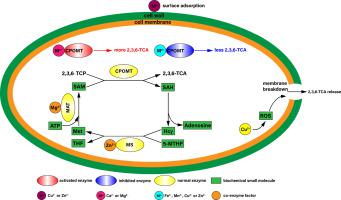Science of the Total Environment ( IF 8.2 ) Pub Date : 2021-02-24 , DOI: 10.1016/j.scitotenv.2021.146054 Xinyan Zhou , Kejia Zhang , Cheng Cen , Jiajia Wu , Xiaogang Wu

|
Haloanisoles (HAs) produced by bacteria have become a nonnegligible taste and odor issue in drinking water. However, the effects of conventional water quality parameters, particularly for metal ions on bacterial HA formation, have rarely been studied. In this study, the effects of six metal ions (Ca2+, Mg2+, Fe3+, Cu2+, Zn2+ and Mn2+) on the formation of 2,3,6-trichloroanisole (2,3,6-TCA) by Shingomons ursincola Z001 (Z001), a typical HA-producing bacterial strain, were explored. The intracellular 2,3,6-TCA produced by Z001 accounted for 87%–96% of the total 2,3,6-TCA. It was found that 1.0–10 mM Ca2+, 1.0–10 mM Mg2+, 0.010 mM Fe3+ and 0.010 mM Zn2+ could promote Z001 to produce more 2,3,6-TCA, while 0.010–0.10 mM Mn2+, 0.010–1.0 mM Cu2+, 0.10 mM Fe3+ and 0.010–1.0 mM Zn2+ reduced 2,3,6-TCA production. The chlorophenol O-methyltransferase (CPOMT) is mainly located in the cytoplasm of Z001 cells. Cell extract experiments demonstrated that Ca2+ and Mg2+ were activators of CPOMT, while Fe3+, Zn2+, Cu2+ and Mn2+ were its inhibitors. Flow cytometry proved that Cu2+ could significantly damage the integrity of cell membrane, leading to the release of 2,3,6-TCA. In addition to CPOMT activity, Mg2+ and Zn2+ may also influence the processes of S-adenosylmethionine cycle. The Z001 cell wall may precipitate Zn2+ and Cu2+ to reduce their toxicities toward CPOMT. According to the obtained findings, strict controls of Ca2+, Mg2+, Fe3+ and Zn2+ during drinking water treatment were proposed to reduce HA contamination.
中文翻译:

金属离子在乌尔氏鞘氨醇单胞菌在饮用水中调节饮用水气味剂(2,3,6-三氯茴香醚)形成中的作用
细菌产生的卤苯甲醚(HAs)已成为饮用水中不可忽略的味道和气味问题。然而,很少研究常规水质参数,尤其是金属离子对细菌HA形成的影响。在这项研究中,六种金属离子(Ca 2 +,Mg 2 +,Fe 3+,Cu 2 +,Zn 2+和Mn 2+)对2,3,6-三氯茴香醚(2,3探索了典型的产生HA的细菌Shingomons ursincola Z001(Z001)的(6-TCA)。Z001产生的细胞内2,3,6-TCA占总2,3,6-TCA的87%–96%。发现1.0–10 mM Ca 2 +,1.0–10 mM Mg 2+,0.010 mM Fe 3+和0.010 mM Zn 2+可以促进Z001产生更多的2,3,6-TCA,而0.010–0.10 mM Mn 2 +,0.010–1.0 mM Cu 2 +,0.10 mM Fe 3+和0.010 –1.0 mM Zn 2+减少了2,3,6-TCA的产生。氯酚O-甲基转移酶(CPOMT)主要位于Z001细胞的细胞质中。细胞提取实验表明,Ca 2+和Mg 2+是CPOMT的激活剂,而Fe 3+,Zn 2 +,Cu 2+和Mn 2+是其抑制剂。流式细胞仪证明Cu 2+可能会严重破坏细胞膜的完整性,导致释放2,3,6-TCA。除了CPOMT活性外,Mg 2+和Zn 2+也可能影响S-腺苷甲硫氨酸循环的过程。Z001细胞壁可能会沉淀Zn 2+和Cu 2+,以降低它们对CPOMT的毒性。根据获得的发现,提出了在饮用水处理过程中严格控制Ca 2 +,Mg 2 +,Fe 3+和Zn 2+的方法,以减少HA污染。











































 京公网安备 11010802027423号
京公网安备 11010802027423号